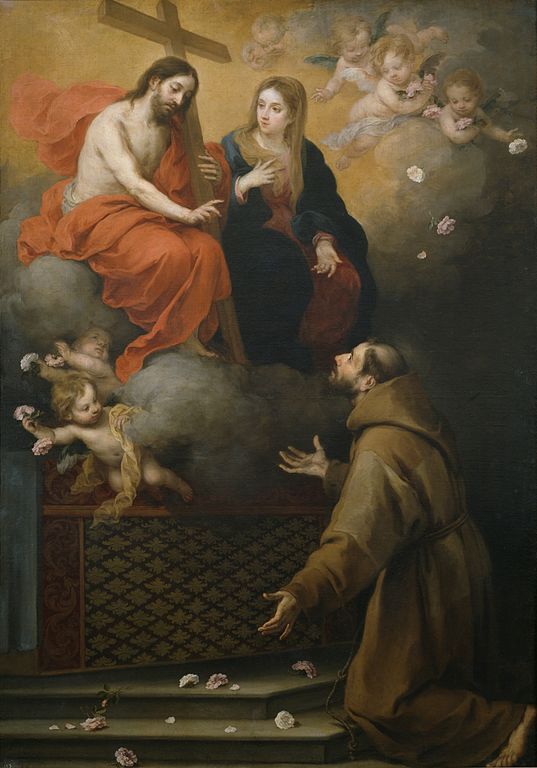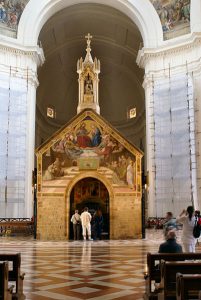On August 2nd each year, Franciscans world-wide celebrate a very special feast day, the Feast of Our Lady of the Angels of Portiuncula.
The Portiuncula — the “little portion” of land — and the chapel which originally sat on it were gifted to Saint Francis of Assisi (1182 – 1226) by the Benedictines in the early years of his conversion from frivolous youth to zealous follower of Jesus and His Gospel.
Thomas of Celano, disciple of Francis and his earliest biographer, describes the chapel as “a church of the Blessed Virgin Mother of God built in ancient times. At that time it was deserted, and no one was taking care of it. When the holy man of God [Francis] saw it so ruined, he was moved by piety because he had a warm devotion to the Mother of all good and he began to stay there continually” (The Life of Saint Francis)
Francis worked with his own hands to restore the dilapidated chapel; the Portiuncula then became the site of numerous significant events in the life of the Franciscan Order.
~ The small initial group of Francis’ followers formed a community of brothers there, living a life of simplicity, poverty, and penance.
~ There, upon hearing Jesus’ injunction regarding poverty of possessions (Mt 10:9 – 10), Francis exclaimed, “This is what I want, this is what I seek, this is what I desire with all my heart.” Putting aside his shoes and staff, he replaced his leather belt with a length of cord and donned a tunic so humble that it didn’t merit a second glance. Thus was initiated the driving force of Francis’ life and the life of the Orders he founded.
~ In those early days, Francis and his first followers set out, two by two, on the first of many itinerant missions, from their Portiuncula home base.
~ As their numbers grew, rapidly and exponentially, the band of friars reconvened at the Portiuncula in annual meetings called chapters. There they prayed together, discussed their Rule, shared stories of their mission experiences, and received new missions.
~ At the Portiuncula, Clare, young daughter of nobility, renounced the world and received the rough habit of the Second Order of Franciscans known as the Poor Ladies, or Poor Clares.
~ In 1216 A.D., Francis experienced a vision of Jesus and Our Lady at the Portiuncula. Francis petitioned the Lord for an indulgence to be granted to all who would visit the tiny chapel. In time, this favor was extended so that today, the faithful who visit any parish church on August 2nd, anniversary of the dedication of the chapel, can receive a plenary indulgence for remission of punishment due to sin under the usual conditions: sacramental confession, reception of Holy Eucharist, prayers for the intentions of the Holy Father, and sincere intention of detachment from all sin.
Thomas of Celano resumes our Portiuncula account at the point where the spiritual life of Francis of Assisi came full circle — from the foundation of his Order to the end of his days on earth. Severely failing in health, “he [Francis] asked the brothers to carry him quickly to the place of Saint Mary of the Portiuncula. For he wanted to give back his soul to God in that place where … he first came to know perfectly the way of truth.”
And so it was that, just as he wished, “… our most blessed father Francis departed from the prison of the flesh and soared to the dwellings of the heavenly spirits. This happened in the city of Assisi where he was born, at Saint Mary of the Portiuncula, where he first planted the Order of Lesser Brothers.”
Thomas of Celano cites Saint Francis’ repeated exhortation to his friars: “‘See to it, my sons, that you never abandon this place. If you are driven out from one side, go back in from the other, for this is truly a holy place and the dwelling place of God … Therefore, my sons, hold this place, God’s dwelling, as worthy of all honor and here praise God in cries of joy and praise with your whole heart.’”
Saint Francis’ wish continues to be honored today. The tiny chapel of the Portiuncula now rests inside the imposing Basilica of Saint Mary of the Angels outside of Assisi. Down through the centuries, pilgrims have continued to flock to the simple structure where the Franciscan Order took root.











